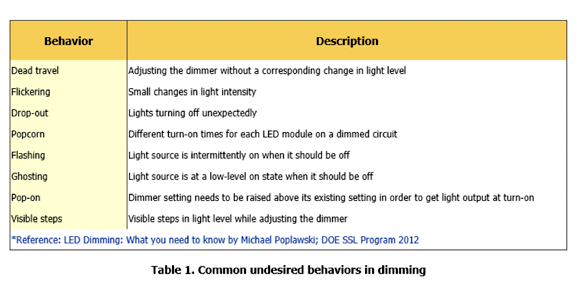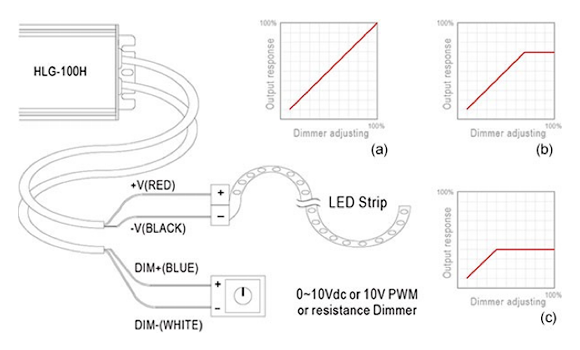|
Finding the right driver for dimming LED strips A question of compatibility.How pulse width modulation (PWM method) prevents frequently occurring problems when dimming LED strips.The problemLED lighting offers many advantages. LEDs are energy-saving and flexible, able to be used in an extremely wide range of situations. Even with dimming, they achieve high efficiency and durability, creating suitably adapted ambient lighting. Even so, a number of points need to be taken into consideration when dimming LEDs: to truly exploit their efficiency and long service life, the LED and driver must be selected and coordinated with care. However, problems may occur during dimming, for example ghosting, dead travel, flicker, or the brightness adjustment occurs in visible steps rather than evenly and continuously. Irritating noises can also accompany dimming (see Figure 1).  | | Figure 1: Common undesired behaviours when dimming an LED. |
|
Simple LED light sources can be divided into two categories: LED diodes only and LED diodes with a series resistor. LED diodes are typically dimmed by limiting the LED current. The LED driver should therefore be designed to meet this demand.
LED sources with a series resistor (e.g. in LED strips) can be operated using a constant voltage power supply or CV LED driver (typically 12 or 24V) to power the LED strip – the voltage is adapted to the LEDs by the resistor. One way to minimise dead travel, for example, is to use a driver at full load. However, this is not always realistic. LED strips are often used for decorative purposes (ambient lighting) and the length of the LED strip cannot be predicted accurately or adapted individually to every LED power supply (see Figure 2).  | | Figure 2: Amplitude current adjustment of the HLG-100 LED driver connected to an LED strip under different load (length) conditions: (a) best dimming performance at full load (length); (b) 70% load (length) with diminished dimming result; (c) 30% load (length) worst dimming result due to high degree of dead travel. |
|
Solutions and examples
• Tip:The best way to dim LED strips is with pulse width modulation, which avoids the above-mentioned dimming issues. With PWM, there is no change in the output voltage, but rather in the time period in which the voltage is applied – the LED is switched on and off at high-frequency.
• The key parameters are the dimming resolution and the PWM output frequency: ideally, to minimise flicker and visual distraction, a PWM frequency of 1.25 kHz or higher should be used. To achieve an 8-bit dimming resolution suitable for most applications, the minimum dimming level should be 0.1%.
The MEAN WELL PWM series offers intelligent control solutions that allow straightforward installation while delivering high performance. With PWM output clocked at up to 4kHz, the units in the series provide a flicker-free lighting experience. They are suitable for a wide range of indoor and outdoor lighting applications, but are especially useful for LED strips of all kinds.
The KNX versions of the PWM series achieve a lower DIMM level of just 0.01%, maintaining colour temperature and brightness homogeneity when operated with all types of LED lighting, even at the lowest brightness levels. The versions with DALI-2 interface dim from 100% to 0.2%. In addition to DALI, the Casambi and Tuya wireless standards, as well as a 1-10 volt analogue-interface version, are also available. These efficient power supplies (efficiency up to 94%) are available with power output from 40W to 200W. They have a wide AC input voltage range from 90V to 305V, and can be operated in ambient temperatures from -40°C to +70°C. The units in MEAN WELL’s PWM series are protected against short circuit, overvoltage/overcurrent and overload (temperature protection), and come in a sturdy, fully insulated plastic housing with IP67 protection.
At Schukat
Schukat electronic offers power supplies from a range of manufacturers, including MEAN WELL, Self Electronics and Recom Power. Schukat stocks around 6000 different types of power supplies and DC/DC converters in production quantities at its automated central warehouse in Monheim am Rhein, Germany.
As a distributor, we provide fast, competent support with direct contact persons, and also offer an expert field service team for on-site problem solving. Customers benefit from rapid processing of enquiries, availability of data sheets and samples, and variable delivery quantities – from samples to series production.
Our technical sales team is here to help when selecting suitable power supply products and for any customer-specific questions relating to peak power
|
|
|















